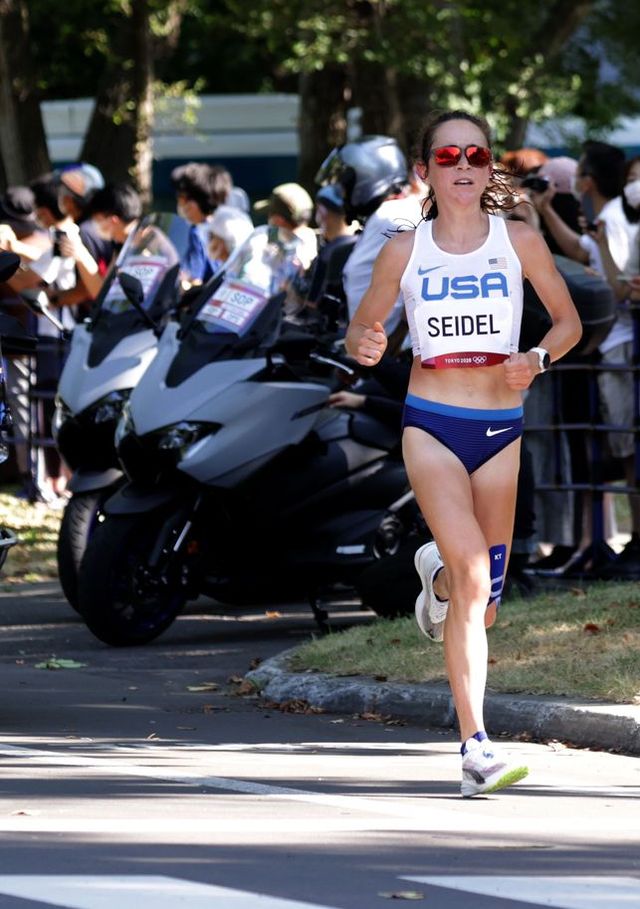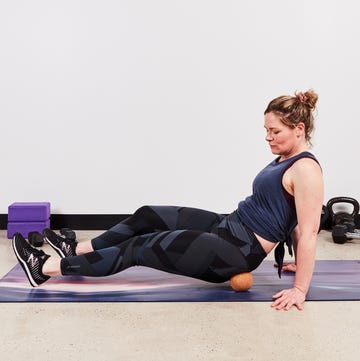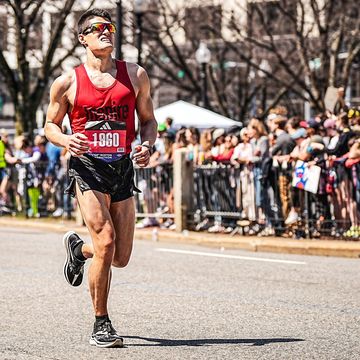Molly Seidel had raced exactly zero marathons before she placed second at the U.S. Olympic Marathon Trials in February 2020; her bronze medal-winning run at the Tokyo Olympics in August 2021 was just her third time competing in the 26.2 distance.
It’s important to note, though, that Seidel already had plenty of experience breaking the tape. She won the Foot Locker Cross Country Championships in high school in 2011, snagged four NCAA titles in the 2015 through 2016 season in college, and she finished first at the Rock ’n’ Roll San Antonio Half Marathon in December 2019 with a time of 1:10:16—the qualifying finish she needed to get to the trials.
Her speed is impressive, of course, along with her ability to show up and win without people even realizing she’s racing. But the 27-year-old also stands out from the competition thanks to a combo of fierce training, always listening to her body first, a seemingly laid-back approach to race day, and her ability to maintain the joy in chasing high mileage.
Seidel’s methods to training and racing clearly translate to medal-worthy finishes, and she talked with Runner’s World about some of her most tried-and-true strategies. Follow her lead to cruising to your next PR. And when you crush that goal time, have a beer in her honor.
Put your plan in pencil, not pen
Jon Green, Seidel’s coach, writes out her training plan a couple months in advance and chats with Seidel about it to make changes—both knowing they’ll revise it a couple times now and many times in the future. That’s because Seidel knows when to take a step back from running, whether from the sport in general, as she did in 2016 or just putting an extra rest day on her calendar. Both Seidel and Green promote adjusting plans and going off how you’re feeling as one of the most important factors in training. So, if one day you feel an injury coming on or you didn’t get any sleep, that’s a clear sign it’s time to skip your workout.
“There are days where Molly is like, I just don’t have it today,” Green, also the head coach of Atalanta NYC, tells Runner’s World. “We always try to listen to that.”
A plan written months ago might not work for you right now, Seidel says. So you have to focus on your fitness and health in the moment to get the most out of your training.
“In my opinion, it is always better to get in a quality workout regardless of what day it is on rather than to push through and stick to the schedule as it is written and risk injury or exhaustion or not getting in the best, most quality workout,” Seidel tells Runner’s World. “You should have the confidence in yourself to say one day isn't going to make a difference."
Enjoy the easy days
Seidel keeps her effort easy on most training days. While her race pace might hit around 5:00/mile, her training runs often hover around eight-minute miles. “Easy miles are kind of the unfussy, unglamorous stuff that actually makes a huge difference,” Seidel says. “So I take my easy miles very easy, but I run a hell of a lot of ’em.”
“A lot of runners, especially new runners, either run too fast every day or too slow every day,” John Honerkamp, a certified run coach with Strava, tells Runner’s World. “If they go fast every day, they're going to burn out and get injured or sick or run down.”
Going too slow every day, on the other day, may help you get and stay fit initially, but it can also get you stuck in a rut. Whether you’re training for a 5K or marathon, Honerkamp suggests paying attention to pace separation or “the difference between your fastest run and your slowest run.” For example, think about your intervals hitting an 8:00/mile pace, while your recovery reaches 12:00/mile. That means your speed varies by about four minutes from push pace to easy pace.
Improve gradually
In Seidel’s mind, it’s truly slow and steady that wins the race—at least when it comes to easy runs and training builds. If you’re looking to hit your fastest goal time, she says you don’t have to do anything drastic to your plan.
“What I’ve found to work over the last year, going from the Olympic trials to London to Tokyo, is finding ways that you can improve your training by doing light modifications,” she says. “I increased my mileage gradually. I maybe did a slightly bigger workout here and there, but there wasn't a whole lot that was drastically different from my previous marathon builds to now other than we refined it a bit more.”
To show just how basic some of her workouts can be, Seidel posts each one on Strava. “I originally just started doing it because I like it as a training log,” she says. “But more than that, I’m showing people that it really isn't rocket science.”
Create a little pre-race ritual
Seidel does six to 10 200-meter repeats about two days before a race—no matter what distance she has on the calendar. “Whether she’s running a mile or she’s running a marathon, she’s doing 200s. It’s a running joke, but it’s one of those things,” Green says, laughing about Seidel trying to fit this last workout in before the big day (a workout they don’t do in any other part of training for a marathon). “Runners like a rhythm and a schedule, and that’s part of the schedule.”
Seidel can’t explain why she loves 200s in those days leading up to races either, except that she’s been doing them since college and they help clear her mind a bit.
“They’re not fast. It’s just casual. And Jon always gives me shit about it,” Seidel says, also laughing. “He’s like, ‘I don’t know anyone who just insists on doing 200s as much as you and you're a marathoner.’ And I’m like, ‘Well, Jon, in my defense, none of your other athletes do 200s and none of them are also bronze medalists. So they work.’” (Touché, Seidel.)
While you might not need 200s on your schedule, having something that brings you calm or gives you confidence in your running ability in the days leading up to race day compares. Maybe it’s a shake out run or an easy couple miles with a few strides at the end—simply find something that works for you and it might become your go-to for nailing race performance like Seidel.
Keep it light, especially at the start
“Racing is about showing off the work we’ve been doing. And it's just a fun thing to do,” Green says about his and Seidel’s mindset when it comes to race day. That’s why, at the start, they’re typically goofing off. At the Olympics, Green taped a big pair of googly eyes up on the door of Seidel’s hotel room, told dad jokes while they waited around in Sapporo, and pretended he would replace her Maurten (Seidel’s fuel of choice while racing) with milk. Even out on the course, Green doesn’t say much to Seidel, besides shouting about having her water and to remember “rule five” or “harden the f--- up”—Seidel’s motto.
To make sure your time at the starting line strikes a positive tone, Green suggests making friends with other runners to lighten the mood and maybe even meet someone you can catch a few miles with during the race. “The running community is a really friendly community and people should take advantage of it,” he says.
Also, Seidel suggests not taking the race in general too seriously. “I think a lot of runners can make the mistake of running with too much gravity,” Seidel says, pointing out that some people think it’s the end of the world if they don’t medal or hit a certain pace. Her approach, as an apparent underdog (until recently): “At the end of the day, if I don’t go out with the leaders and I blow up spectacularly, no one’s going to give a shit. Ultimately, no one expects anything of me anyway. So, I might as well just go for it.”
Embrace the boredom
When Seidel started running marathons instead of 10K races, she realized the need for mental stamina.
“Part of [mental marathon training] is getting comfortable with being uncomfortable for long periods of time. And likewise getting very used to being really bored,” she says. “A lot of times, I won’t listen to music or anything when I run to practice that feeling of being like, ‘okay, this sucks. And I just have to sit with this feeling for the next hour or so.’”
To get through times when she’s bored and shuffling her feet, Seidel goes through a running form check list. She also counts or repeats songs in her head. “For the most part, I focus on getting into a Zen mental state,” she says, similar to meditation. “You’re just focused, but not focusing—almost like your brain is soft and things are just happening and you're taking it as it comes.”
Because of this mental approach, Seidel says people often ask what she was thinking about during the Olympic marathon, and she doesn’t have a concrete answer. “I truthfully don’t think about a whole lot, except reacting to the moment and just going along with it, but they’re not conscious thoughts.”
Snap back from disappointment
In training, Seidel also works on bouncing back mentally if something doesn’t go right. If she misses a certain split or mile time, for example, she’ll work on refocusing, staying positive, and just resetting—instead of thinking the whole workout is lost.
“It’s something that I definitely struggle with,” she says. “But in a marathon, you can't take a five-minute breather and just start all over again. You have to be able to work with it in the moment.”
One interval convo she has to snap out of hard patches goes something like, “Stop complaining, stop feeling sorry for yourself. You're not special, you're fine.” “It sounds harsher than it is,” she says.
While she clearly crushed the Olympic marathon with her bronze-medal finish, Seidel did have to force herself into a positive, keep-pushing mindset. At one point, she resigned to the fact that she’d get fourth place. “I thought, ‘This is so hard and you're going to miss out on a medal by one place, but you don't get to feel sorry about yourself when you're running as hard as you can,” she says. When Chemtai Salpeter dropped back with about three miles to go, that mentality gave her the drive she needed to keep going—and it got her to the podium.
Aim for even to negative splits
You can see Seidel’s entire marathon performance on Strava, and her splits hold steady around 5:30 (plus or minus about 15 seconds) from the first mile straight through the last—not an easy feat when you’re going for 26.2 miles. Her second half also averaged a faster pace than the first.
Holding strong for that long comes with practice, particularly in your training, says Honerkamp. “I always preach that in workouts, whether it's interval training or tempo runs, to maintain your pace or gradually get faster,” he says. “The more even you can run, the better you're going to do as far as the efficiency of burning fuel and being more relaxed.”
Lots of times, people start out too fast on race day, which can kill that even- or negative-split goal. Make sure you go at a pace that feels easy, even if the crowds have you revved up. Knowing your goal pace for the race—and easing into it, then sticking to it—will also help, Honerkamp says.
Seidel also mentions that conserving the legs a bit in the beginning of the race is key to a strong finish. “I’ve found it’s a 20-mile lead into a 10K road race,” she says. “So it’s about using the first chunk of the race—whether that’s the first half or the first two thirds—to prep your body for the final part,” she says.
In addition to pacing properly, you also have to fuel right, getting enough carbs and calories to maintain your stamina through the later miles. While nutrition can deeply vary from person to person, Seidel goes for 50 grams of carbs per hour, taking a fluid (not gels), starting around the 5K mark.
Know (and trust) your body
Seidel doesn’t go into races with a set plan or even set paces to hit. Instead, she just lets her body do its job.
“Molly's race strategy looked bold [in the Olympics] and like she was up front and sticking her nose in there and whatnot. But at the end of the day, what we work on a lot is going off of feel and we really listen to her body,” Green says. “So that was more so Molly just listening to her body during the race.”
Green and Seidel practice that run-how-you-feel approach in training. While Green does prescribe paces for Seidel’s workouts, there’s often wiggle room. For progression runs, for example, he’ll set the starting pace and maybe how to progress it, and then just a hard speed limit, so she has a range of paces. This allows Seidel to check in with how she’s feeling on a certain day, Green says.
Seidel says it was Green who gave her the autonomy to listen to her body more.
“In the beginning of my pro career, I was trying to fit into this box which happens so often when you’re in a professional group. It definitely didn't work for me,” she says. “[Green] treated me like an adult that knows what is going on with my body. And just that trust—him treating me like a peer rather than dictating my training to me from on high—I think that was truthfully the switch that I needed.”
Just enjoy it
Ultimately, if you just have fun in your workouts and races, each mile will be worth it. “[Seidel] enjoys training and running and she also enjoys drinking beer, which not everyone in the professional running scene does,” Green says. (Seidel now infamously told her family and friends to have a beer for her in her post-Olympic interview.) “She just enjoys the process at the end of the day. And that’s what makes her so good.”
“Being able to treat [racing] like the fun, cool, awesome thing that it is—I feel like that helps to just reinforce in my mind that this isn't the be all, end all. This is a cool, amazing thing that I get to do. And I’m really lucky that I get to do it and be here with my best friend, [Jon]. We’re just hanging out in Sapporo, like who the hell thought we would be here?” Seidel says, when talking about how she calmed pre-race nerves at the Games. “I feel like [that mindset] helps take off some of the pressures of the race and then frees up my mind to be able to actually go out and do what I know how to do.”
Something she certainly knows how to do? Race big.
Mallory Creveling, an ACE-certified personal trainer and RRCA-certified run coach, joined the Runner's World and Bicycling team in August 2021. She has more than a decade of experience covering fitness, health, and nutrition. As a freelance writer, her work appeared in Women's Health, Self, Men's Journal, Reader's Digest, and more. She has also held staff editorial positions at Family Circle and Shape magazines, as well as DailyBurn.com. A former New Yorker/Brooklynite, she's now based in Easton, PA.













